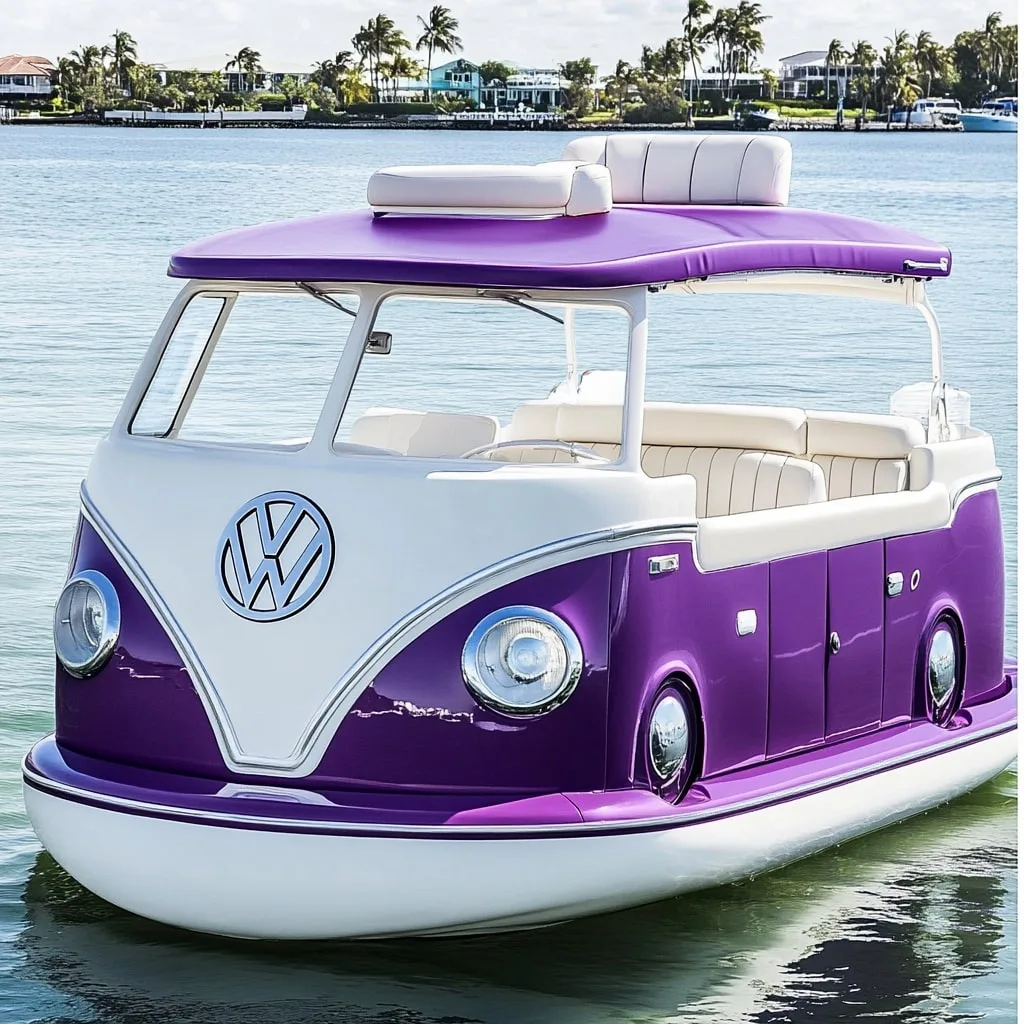The distinctive curves of a Volkswagen Beetle or the iconic silhouette of a VW Bus have become design classics that transcend the automotive world. While these German vehicles have earned their place in transportation history on roads worldwide, their influence has sailed into unexpected waters—quite literally. Volkswagen-inspired boats represent a fascinating intersection of automotive heritage and maritime design, where the beloved aesthetics of VW vehicles take on new life on the water.
This unique design crossover speaks to the enduring cultural impact of Volkswagen’s most iconic models. From DIY enthusiasts crafting homemade tributes to professional boat builders developing commercial models, the marriage of VW styling and watercraft functionality creates vessels that are both nostalgic and innovative. These boats combine the practical German engineering ethos of Volkswagen with the freedom and adventure associated with boating.
In this comprehensive exploration, we’ll navigate through the history, design principles, notable examples, and future outlook of Volkswagen-inspired boats. Whether you’re a classic car enthusiast, a boating aficionado, or simply appreciate unique design, these nautical adaptations of automotive classics offer an intriguing glimpse into how iconic design language can be reinterpreted across different modes of transportation.
The Origins of Volkswagen-Inspired Boat Design
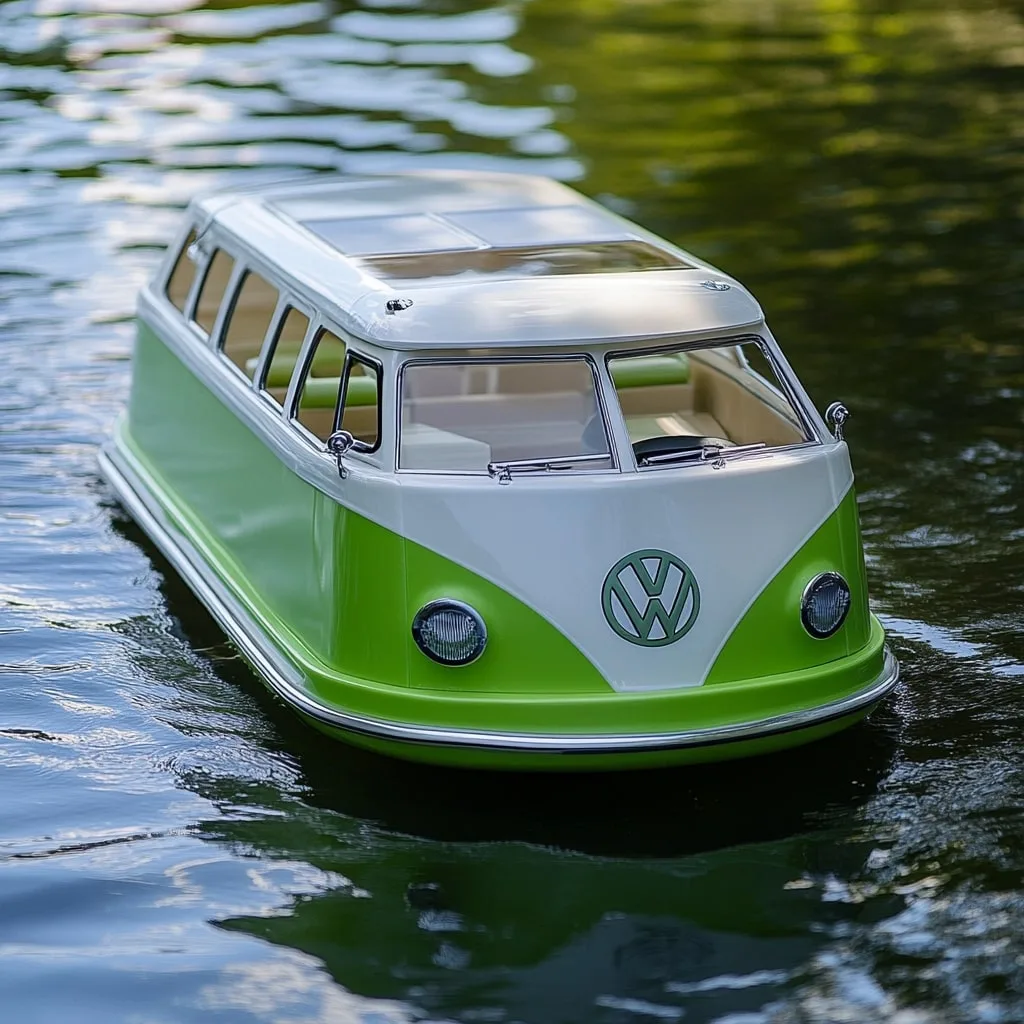
The Volkswagen Design Language
Volkswagen’s most iconic vehicles—particularly the Beetle (Type 1) and the Bus (Type 2)—feature distinctive design elements that have made them instantly recognizable worldwide. The rounded, friendly silhouette of the Beetle and the boxy yet approachable form of the Bus both represent a design philosophy built around simplicity, functionality, and accessibility.
These vehicles emerged from post-war Germany as practical transportation solutions, but their unpretentious charm and distinctive styling quickly earned them cultural significance far beyond their utilitarian origins. The curved fenders, circular headlights, and compact proportions of classic VWs have become design touchstones that evoke nostalgia and warmth across generations.
Early Maritime Adaptations
The first Volkswagen-inspired boats began appearing in the 1960s and 1970s, coinciding with the peak popularity of the VW counterculture in America and Europe. Early examples were often handcrafted projects by enthusiasts who sought to translate their love for these vehicles into watercraft that captured the same spirit.
These pioneering designs frequently incorporated salvaged parts from actual Volkswagen vehicles—steering wheels, dashboards, and emblems would find new life on the water. The boats weren’t merely decorated with VW accessories; rather, their entire hulls and structures were designed to evoke the proportions and character of the road-going originals.
Popular Volkswagen-Inspired Boat Models
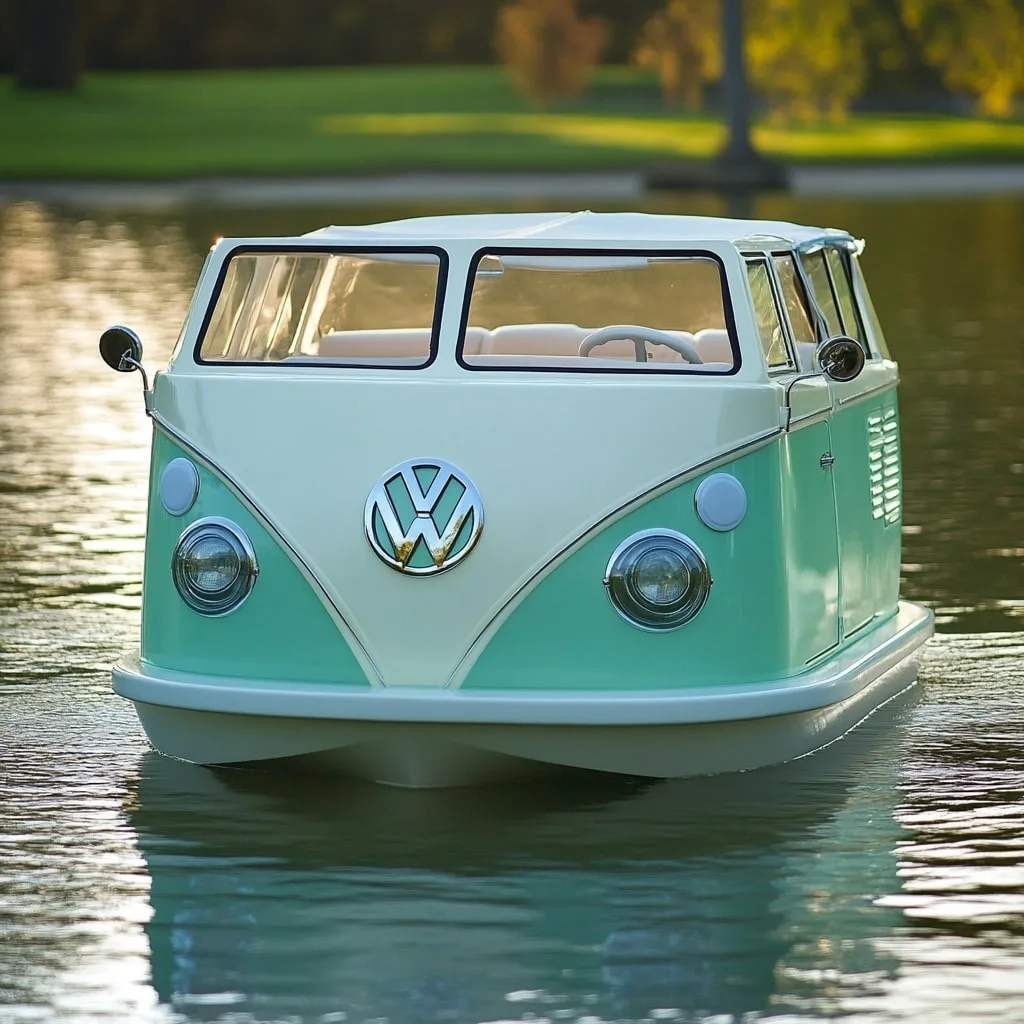
The Beetle Boat
Perhaps the most natural translation from land to water is the VW Beetle-inspired boat. The rounded hull of traditional boats already shares some commonality with the Beetle’s curved form, making this adaptation particularly successful. Beetle boats typically feature:
- A rounded hull mimicking the Beetle’s distinctive shape
- Prominent curved fenders extending over the waterline
- Circular porthole windows echoing the car’s headlights
- A sloping rear deck reminiscent of the Beetle’s engine compartment
- Classic VW color schemes including baby blue, bright red, and sunshine yellow
Notable examples include the “Volkswagen Aquatic,” a custom-built Beetle boat that gained attention at boat shows in the early 2000s for its remarkable fidelity to the original car’s proportions while maintaining seaworthy characteristics.
The Bus Boat
The VW Bus or “Kombi” has inspired equally creative maritime interpretations. These designs translate the boxy, utilitarian shape of the Type 2 into functional watercraft that maintain the van’s distinctive profile while accommodating the requirements of water travel.
Typical features of Bus-inspired boats include:
- A flat, vertical front resembling the Bus’s iconic face
- Split windshield design similar to early VW vans
- Side “windows” that maintain the horizontal banding of the original
- Two-tone paint schemes mimicking classic VW livery
- Roof racks and other accessories that reference the Bus’s utility
One famous example is the “Boatswagen,” a 20-foot vessel built by a team of enthusiasts that perfectly captures the spirit of the 1960s VW camper van while functioning as a fully operational motorboat.
DIY vs. Commercial Volkswagen-Inspired Boats
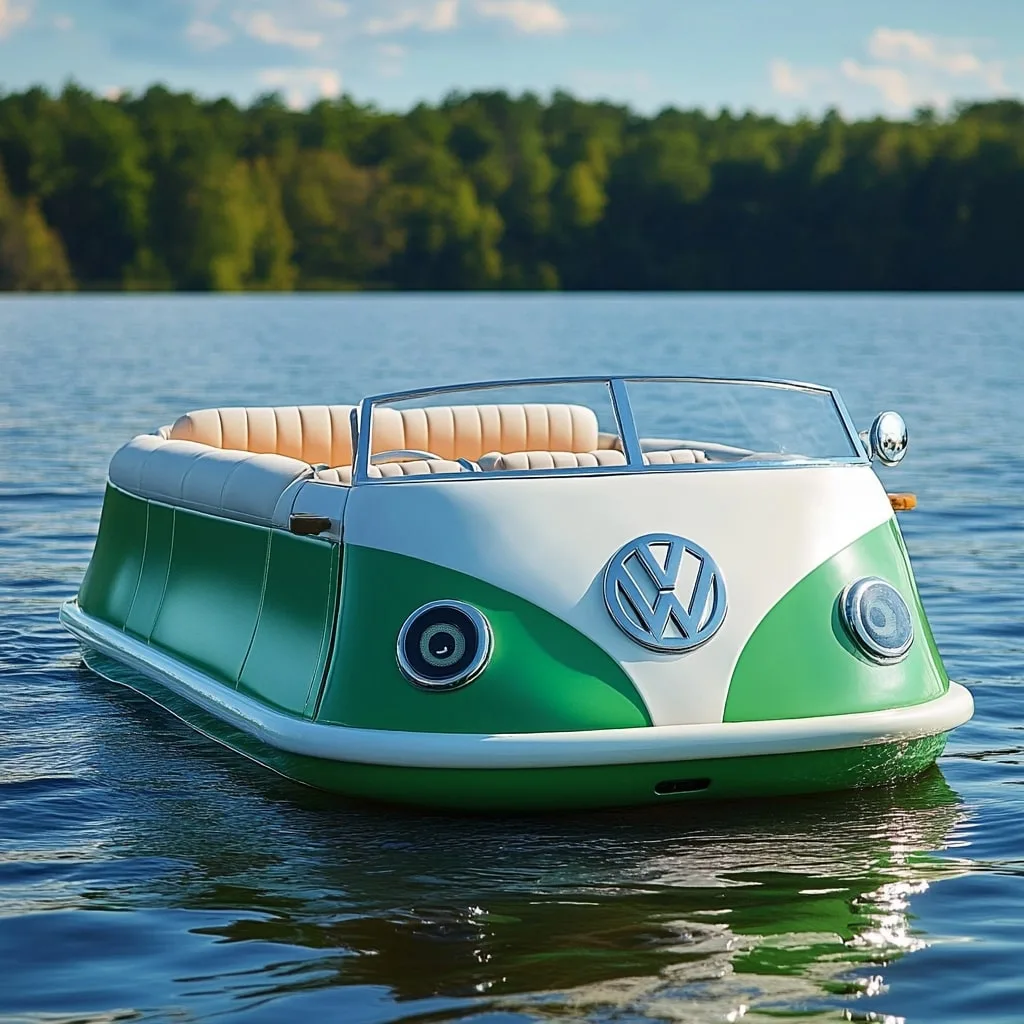
Homemade Projects and Enthusiast Builds
Much of the charm in the world of Volkswagen-inspired boats comes from one-of-a-kind creations by passionate builders. These DIY projects range from simple visual modifications of existing boats to ground-up custom builds that require considerable boatbuilding expertise.
The DIY approach typically involves:
- Fiberglass molding to recreate VW body curves
- Repurposing genuine VW parts for authenticity
- Custom paint jobs matching factory VW color codes
- Interior details that mirror the vehicles’ cabins
- Creative adaptation of automotive elements for marine use
The internet has allowed these builders to share techniques and showcase their projects, creating a small but dedicated community around these specialized watercraft.
Commercial Offerings and Limited Production Models
Beyond individual projects, several companies have recognized the appeal of Volkswagen-inspired boats and developed commercial versions. These range from small production runs to concept designs showcased at boat shows.
Notable commercial examples include:
The Dutchmann Swordfish TS
This South African creation combines classic Porsche and VW design elements with high-performance boating. While not strictly a VW replica, its aesthetic draws heavily from the shared design heritage of these German marques.
The Herbie Replica Speedboat
Based on the famous “Love Bug” movie character, this commercial model faithfully reproduces Herbie’s racing stripes and number 53 in boat form, with production limited to collectors and theme parks.
Technical Challenges of Adapting Automotive Design to Watercraft
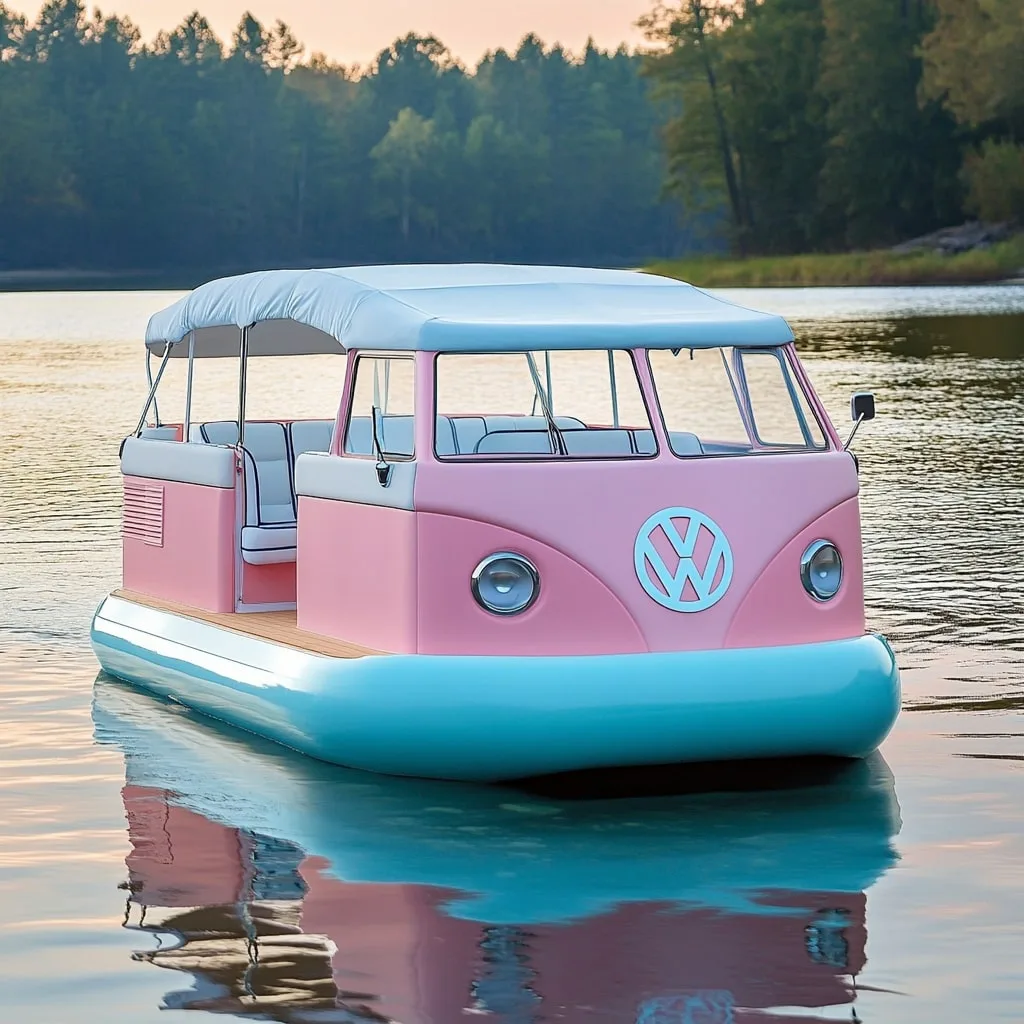
Hull Design Considerations
Translating automotive shapes to functional boat hulls presents significant engineering challenges. While cars are designed primarily for aerodynamics and road handling, boats must contend with hydrodynamics and stability concerns.
Key challenges include:
- Adapting the flat underside of vehicles to planing or displacement hulls
- Ensuring stability despite asymmetrical design elements
- Balancing aesthetic faithfulness with maritime performance
- Incorporating functional elements like propulsion and steering systems
Successful Volkswagen-inspired boats manage to suggest the vehicle’s shape while making necessary compromises for seaworthiness.
Materials and Construction Techniques
Modern Volkswagen-inspired boats typically utilize materials and construction methods that differ significantly from their automotive inspirations:
- Fiberglass and composite materials replace sheet metal
- Marine-grade components substitute for automotive electronics
- Waterproofing and corrosion resistance take priority
- Structural reinforcement accommodates different stress patterns
Despite these differences, skilled builders manage to capture the essence of VW design using these alternative approaches.
The Cultural Impact of Volkswagen-Inspired Boats
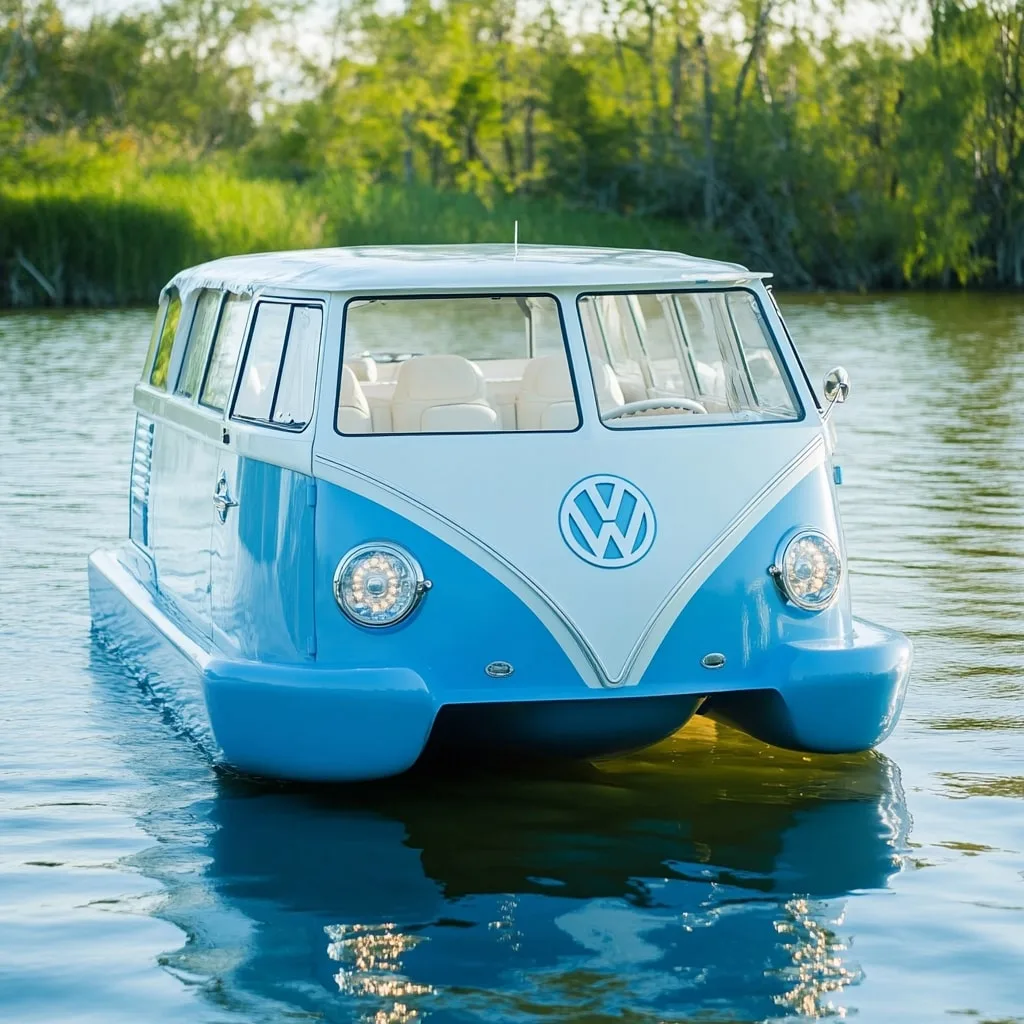
Nostalgia and Heritage Preservation
Like classic car restoration, Volkswagen-inspired boats often serve as floating tributes to automotive heritage. Many builders and owners have personal connections to the original vehicles, with the boats representing an extension of their passion for VW culture.
These watercraft frequently appear at both car shows and boat shows, bridging communities and preserving design heritage in a unique format. They serve as conversation starters and living museums of mid-century design principles.
Creative Expression and Customization Culture
The modification culture surrounding Volkswagen vehicles—particularly the extensive customization scene for Beetles and Buses—finds natural extension in boat building. Owners often personalize their VW-inspired vessels with:
- Custom paintwork including period-correct graphics
- Themed interiors reflecting specific VW models or eras
- Performance modifications for improved water handling
- Personalized details telling the owner’s unique story
This creative expression mirrors the deeply personal nature of VW enthusiasm in the automotive world.
Environmental Considerations and Future Developments
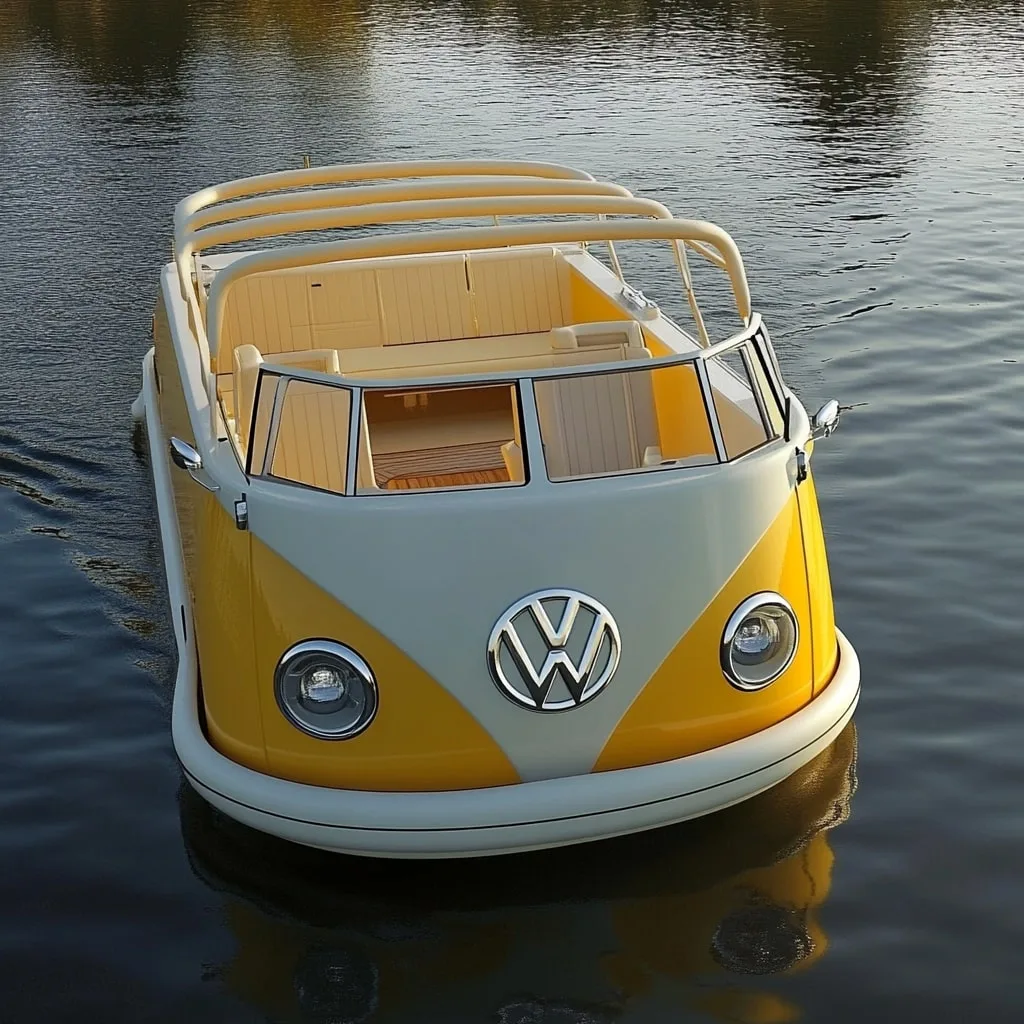
Eco-Friendly Propulsion Options
Modern Volkswagen-inspired boats increasingly incorporate environmentally conscious design elements, reflecting both maritime regulations and the growing emphasis on sustainability in transportation:
- Electric motors replacing traditional outboards
- Solar panels integrated into the design
- Sustainable building materials and processes
- Reduced emissions systems for conventional engines
These developments parallel Volkswagen’s own pivot toward electric vehicles, creating interesting convergence between the automotive original and its maritime interpretations.
Concept Designs and Future Possibilities
Looking forward, designers and enthusiasts continue to explore new possibilities for Volkswagen-inspired boats:
VW ID-Inspired Electric Watercraft
Taking cues from Volkswagen’s modern ID electric vehicle lineup, several concept designs envision sleek, battery-powered watercraft that maintain VW’s distinctive design language while embracing cutting-edge technology.
Amphibious Adaptations
Some ambitious projects aim to create true amphibious vehicles that operate both on land and water, fulfilling the ultimate crossover between automotive and maritime functions while maintaining Volkswagen’s iconic styling.
How to Experience Volkswagen-Inspired Boats
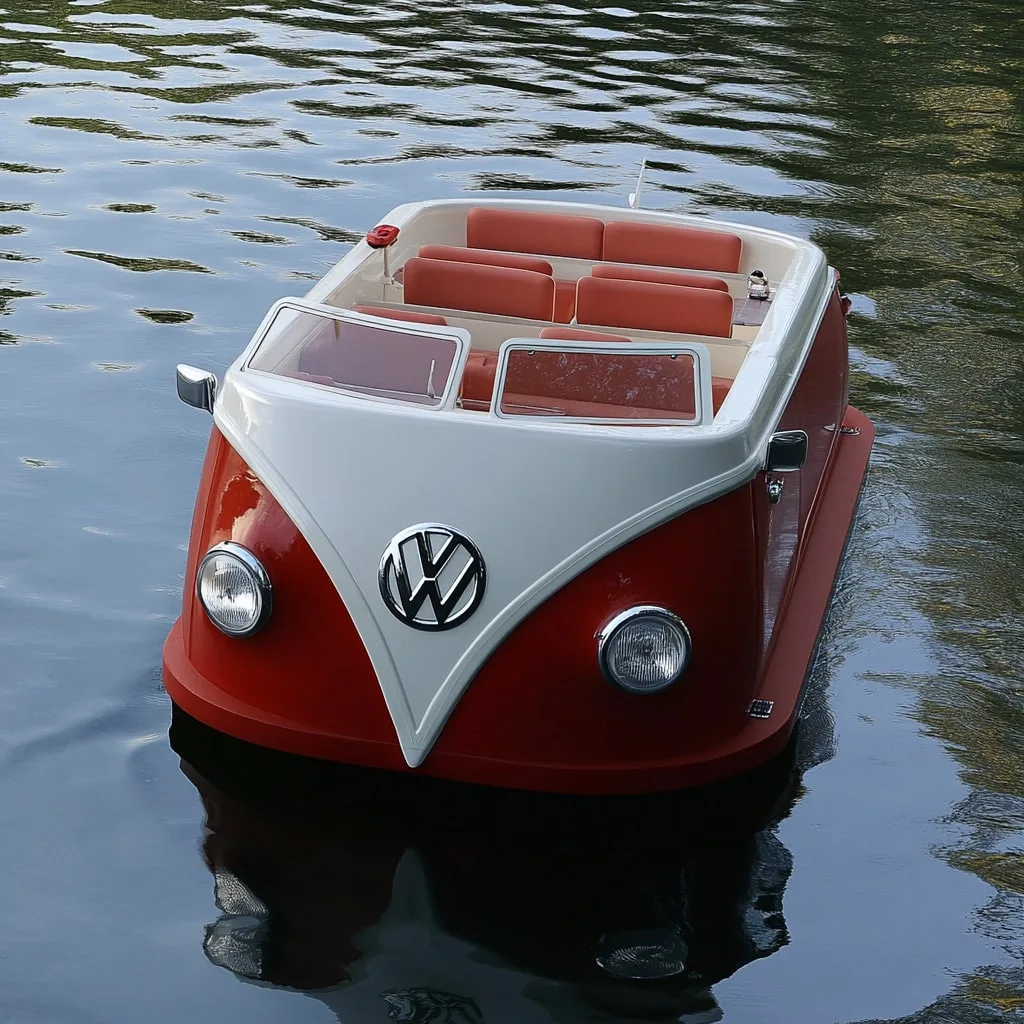
Boat Shows and Enthusiast Gatherings
For those interested in seeing these unique vessels in person, several venues offer opportunities:
- Classic boat shows often feature sections for novelty and themed craft
- VW enthusiast gatherings occasionally include maritime adaptations
- Lakeside VW meetups where automotive and boating cultures intersect
- Maritime museums with exhibits on recreational boating evolution
Rental and Charter Opportunities
In certain vacation destinations, particularly those with strong VW cultural connections, specialty rental companies offer experiences with Volkswagen-inspired boats:
- Lake Havasu, Arizona features several VW-themed rental boats
- Coastal California towns with deep surf culture connections
- Parts of Germany where automotive tourism intersects with boating
- Select Mediterranean resorts catering to design enthusiasts
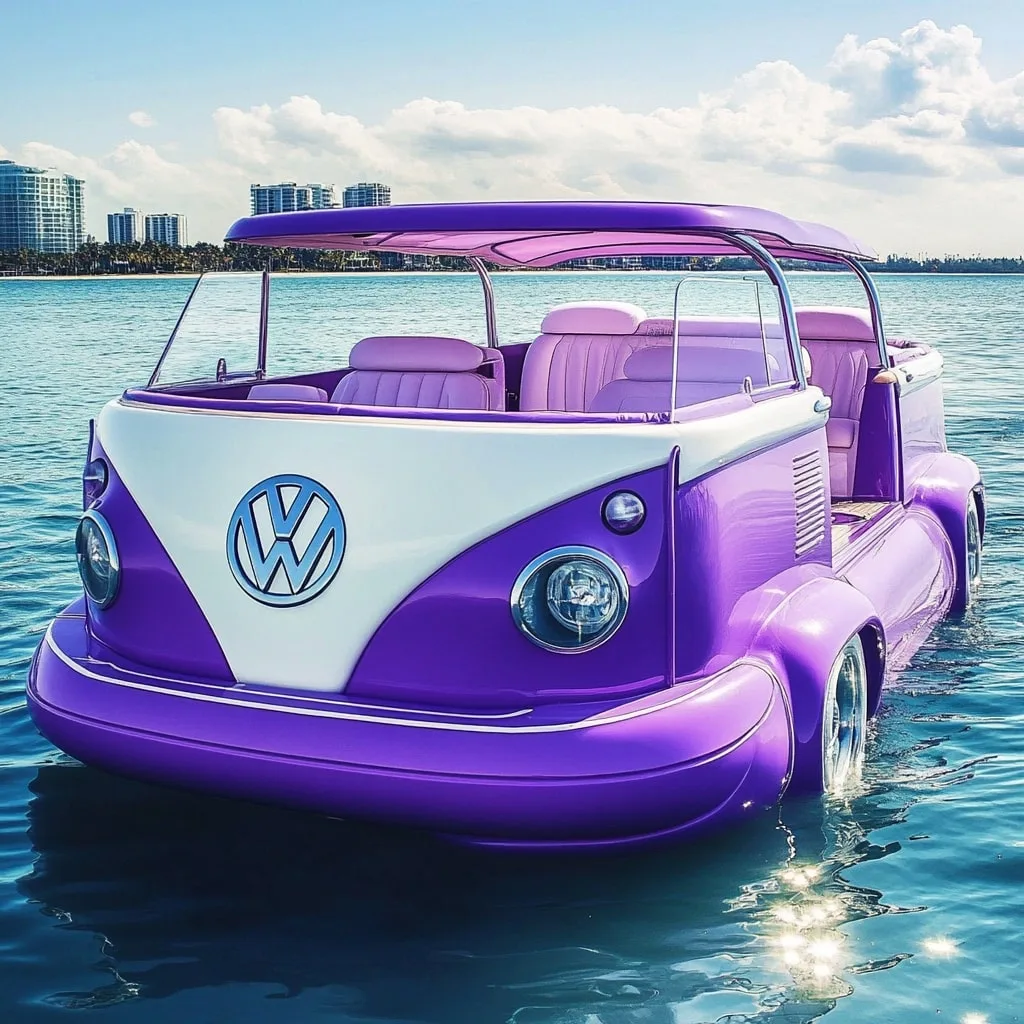
Conclusion
Volkswagen-inspired boats represent a charming confluence of automotive history and maritime adventure. These vessels do more than simply decorate conventional boats with VW logos or colors—they translate the fundamental design language of iconic vehicles into functional watercraft that capture the spirit and character of the originals.
The enduring appeal of these crossover creations speaks to the timeless nature of Volkswagen’s most beloved designs. Whether rendered as meticulously detailed replicas or loose interpretations that merely suggest their automotive inspiration, these boats demonstrate how distinctive design principles can transcend their original medium and find new expression.
For enthusiasts of both classic automobiles and unique watercraft, Volkswagen-inspired boats offer a specialized niche where passion for heritage, craftsmanship, and adventure converge. As both automotive and maritime design continue to evolve, these creative adaptations serve as floating reminders of the cultural impact of Volkswagen’s most iconic contributions to transportation design.
Whether you’re a dedicated VW collector considering a nautical addition to your fleet or simply an admirer of creative design crossovers, these distinctive vessels prove that some ideas are simply too good to remain on land. The world of Volkswagen-inspired boats invites us to imagine transportation design not as separate categories but as a continuous spectrum of possibilities where iconic shapes and beloved brands can find new life in unexpected environments.

